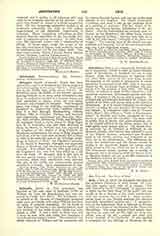

Area, a box in which the Eucharist was kept by the primitive Christians in their homes. St. Cyprian (De lapsis, xxvi) tells of a woman “who with unworthy hands” attempted “to open her box in which was the Holy (Body) of the Lord”, but was unable to do so because of fire which issued there from the moment she touched it. (Cum quaedam arcam suam in quo Domini sanctum fuit manibus immundis temptasset aperire, etc.) A representation of the Eucharistic Area is believed by Wilpert to exist in a fresco of the catacomb of Sts. Peter and Marcellinus. The scene depicts Christ seated, reading from an open roll; on His right are three amphorae, and on the left a square box filled with loaves, symbols of the Eucharist. It also signified a receptacle for the offerings of Christians for the Church or the poor (Tert., Apol., xxxix; Liber Pontif., I, 154).
MAURICE M. H ASSETT

